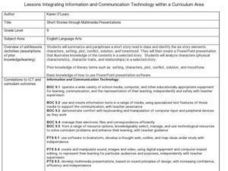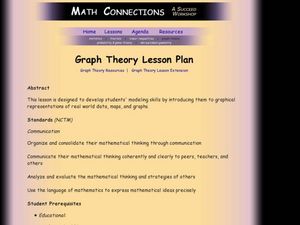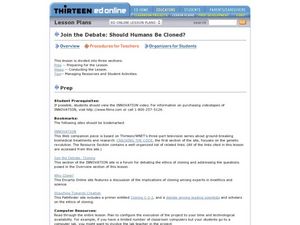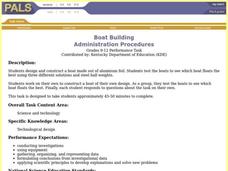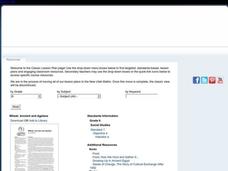Curated OER
DNA in a "Snap"
Students observe a model of DNA and answer probing questions like, "What does this model represent?" They then work in small groups to construct an accurate model of DNA per rubric provided and present to the class explaining their model...
Curated OER
Short Stories Through Multimedia Presentations
Ninth graders summarize and paraphrase a short story read in class. They identify the six story elements of character, setting, plot, conflict, solution, and tone/mood. Students create a PowePoint presentation that illustrates the...
Curated OER
Character Development Through Reader's Theater
Ninth graders study a piece of literature, adapt it into a script and perform the piece to the class. Students practice reading their scripts. They use Inspiration software to create a multimedia presentation.
Curated OER
Watch the Sky for Lightning
Students identify lightning in pictures from the provided Internet site. They study a definition of lightning as a form of heat energy that can be dangerous. They state and illustrate a minimum of three lightning safety rules.
Curated OER
An Encyclo-ME-dia for Every Child
Learners create a digital scrapbook that shows information-text and pictures that are specific to each child. They make charts and graphs. They use digital cameras, scanners, software, to write captions, stories, poems, letters, and...
Curated OER
Graph Theory
Students explore the concept of graph theory. In this graph theory lesson, students participate in hands-on activities that enforce graph theory. Students manipulate graph applets on the internet. Students create a graphical model of...
Curated OER
Some of Its Parts
Young scholars study a can opener to find the important parts that make it possible to take the lid off a can of food. They then use this information to decide what new or different subsystems could be added to make it better and...
Curated OER
Native American Legends
Students work together in groups to research a Native American legend. They present the information they gathered in a format they chose. They write their own legend based on their research.
Curated OER
Should Humans Be Cloned?
Students explore links on the Internet to collect facts about cloning then prepare an essay on their findings. In this research writing instructional activity students examine how to include their opinions on what they have found in...
Curated OER
Flavors and Favors
Students conduct a food drive. In this service learning lesson, students put on a school-wide food drive, decorate the bags the food will be delivered in and possibly even help distribute the food.
Curated OER
Dawdle Duckling
Young scholars read the book Dawdle Duckling and complete different activities about the book. Students research the wetlands, research ducks, complete an oil and water experiment, map a cove, and more.
Curated OER
Oil Spill
Pupils use one of four absorbent products to separate as much of the oil and water mixture they are able to do. The purpose of this task is for students to collect and analyze data for the purpose of determining which absorbent is best,...
Curated OER
Deliver
High schoolers measure the mass, volume, length and area of various objects. They are assigned a letter. The task is assesses students' abilities to make simple observations and measurements.
Curated OER
Instruments and Measurement
Students circulate through stations to determine the proper instrument to make a certain type of measurement. They must make measurements of mass, volume, length, area, electrical current, temperature and force.
Curated OER
Boat Building
High schoolers design and contrast a boat made out of aluminum foil. They test the boats to see which boat floats the best using three different solutions and steel ball weights. Students work on their own to construct a boat of their...
Curated OER
Rate of Cooling Experiment
Ninth graders measure the insulation properties of different fabrics by immersing cans of water covered with fabric "socks" in an ice bath and measuring temperature changes. They then calculate heat loss and graph the data individually.
Curated OER
Acrostic Poems: What's In a Name?
Students find words that begin with the letters in their own names, using a variety of sources including word banks and online dictionaries. They create an acrostic poem. Pupils revise poems as needed, for meaning and conventions. ...
Curated OER
Algebra I Project: Make Your Own Business
Students explore the concept of algebra in real world situations. In this economics lesson, students design, plan, run, and evaluate a small business. Students will create a product, market the product, and try to make a profit.
Curated OER
Ancient Mediterranean Lands: A Timeline of Mediterranean Civilizations
Sixth graders explore world history by participating in a class agriculture activity. In this wheat weaving lesson, 6th graders identify the different Mediterranean regions that adopted early agriculture methods and expanded their...
Curated OER
Loco for Cocoa
Sixth graders explore agriculture by viewing food related videos in class. In this chocolate identification lesson, 6th graders discuss the healthy aspects of pure cocoa and the history of the plant. Students read assigned text about...
Curated OER
More Than One Grain of Rice
Sixth graders explore cultural habits by viewing food videos in class. In this agriculture instructional activity, 6th graders identify the importance of rice in the human diet and how different cultures prepare the food. Students view...
Curated OER
Next Year's Seeds
Sixth graders explore agricultural issues using math and probabilities. In this agriculture lesson, 6th graders investigate real world situations in agriculture using math and probabilities.
Curated OER
Wheat: Ancient and Ageless
Sixth graders investigate the role of wheat in society. In this Social Studies instructional activity, 6th graders explore wheat production from ancient civilizations to modern times. Students describe wheat's importance in shaping culture.
Curated OER
BUS: Farming: It's A Fact (Ag)
Students create two different types of graphs from the information in the "Farm Facts" booklet (i.e., bar graph, pie chart, etc.). They calculate where your food dollars are spent (on and off farm).

